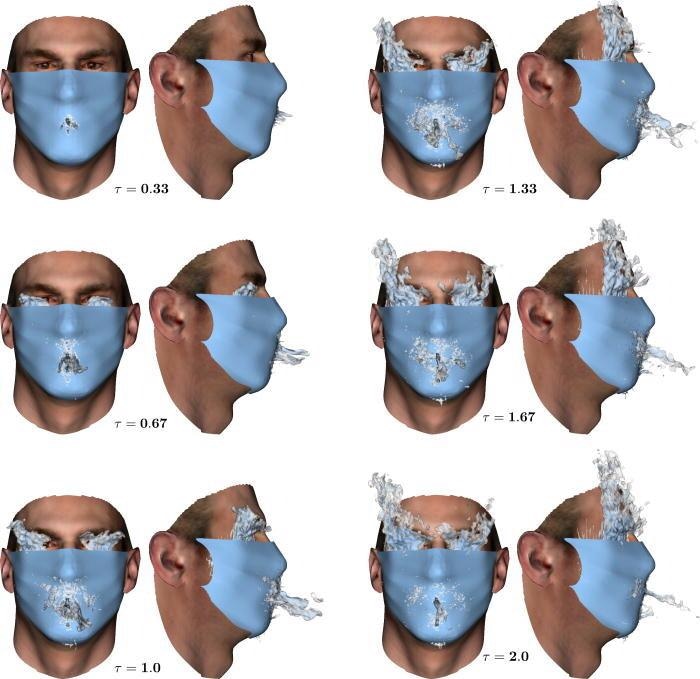According to recent investigations, the efficiency of face masks is determined not just by the mask's material but also by how well they fit on the wearer's face. The quantity of filtered flow and perimeter leakage depends on the mask fit and porosity. Lower porosity typically links with improved filtering. However, it also leads to more perimeter leakage.
The resulting leakage jets that emerged from distinct types of mask porosities and faces are particularly fascinating. Quantifying the proportion of perimeter leaks could be done using direct simulation studies of the flow dynamics of respiratory incidents while wearing a face mask.
About the study
In the present report, the researchers provided a new model for porous membranes, such as masks. Using this model, they were able to examine the leakage rates of a cloth face mask on a realistic face derived from a population survey.
The team employed a porous membrane model with an immersed border and diffuse interface to investigate the flow physics exhibited by face masks. They assessed the fluid dynamics of a coughing individual with a generic face mask.
Instead of a generic manikin face, a three-dimensional (3D) model of headform built from 100 female and male volunteers utilizing a structured principal component analysis (PCA) technique was used in this study. The mask was deployed on the face utilizing a minimal energy approach to achieve a realistic and precise fit. Further, the flow distribution for various mask porosities was investigated using a cough jet with a peak velocity of 10 m/s created at the mouth.

Time evolution of cough while wearing a face mask. Image Credit: Tomas Solano
Results and conclusions
The study results demonstrated that as the porosity of the face mask rises, so does the flow through it. On the contrary, the gap leakage was correlated inversely to the porosity of the mask. Reduced mask porosity (high Darcy coefficients (ck)) causes through-mask leakage to behave substantially different from greater mask porosity (low ck).
An initial uniform stream in which the cough jet first intrudes on the face mask and a subsequent stream near the chin describe the leakage from the face mask with low porosity. The secondary stream was caused by the excessive pressure where the face and mask intersect at the chin. With increasing mask porosity, the through-mask flow rate rises. Throughout the face mask, the pressure gradient decreases and becomes more consistent as the porosity of the mask increases, resulting in a much more distributed and uniform flow through the mask.
With loose-fitting masks, the efficacy of face masks toward airborne transmission was considerably diminished, with fitted filtration efficiency (FFE) as low as 5%. According to the authors, even the efficiency of N95 respirators might be 50% decreased. They also demonstrated that double masking might not increase the outer protection of masks much. While the extra layers should enhance total filtering effectiveness (FE), they also reduce porosity. A negative impact of heightened unfiltered flow via the peripheral gaps was induced by increased porosity, even if accompanied by a bigger FE, among loose-fitting face masks.
In the example reported in this research, the mask fitted well on the male's face with little to no gaps near the bottom and sides of the mask. Nevertheless, large gaps surrounding the nose, which could be reduced by a bending metal clip, led to a path for unfiltered flow leakage. The findings confirmed that a proper fit on the face, i.e., reducing gaps, was critical for a successful face mask.
Furthermore, if gaps were inevitable, the choice of mask designs that actively divert unfiltered flow in a more harmless direction would be dependent on the ambient flow, which was defined by the type of ventilation system utilized. Rerouting the unfiltered leakage flow upwards in a displacement ventilation system would be advantageous in removing the virus-laden aerosol from the room.
Diverting the unfiltered flow upwards in a combined ventilation system, on the other hand, improves the dispersion and mixing of the aerosols throughout the room, particularly in the breathing zone. One possibility was to guide the unfiltered flow downward and onto the mask wearer's chest, increasing the chances of the aerosols adhering to the subject's external surface and not dispersing into the surroundings. On the other hand, better mask designs can help relieve the problem by reducing gaps as much as possible while keeping the leaked flow to a minimum in the inevitable gaps.
Overall, the study findings illustrated that the increased porosity of face masks reduces perimeter leakage, implying that there might be an ideal porosity that reduces total and maximum leakage velocities. The present model could help quantify the efficacy of face masks and inform future mask designs that restrict or divert leakage jets to prevent the distribution of respiratory aerosol.